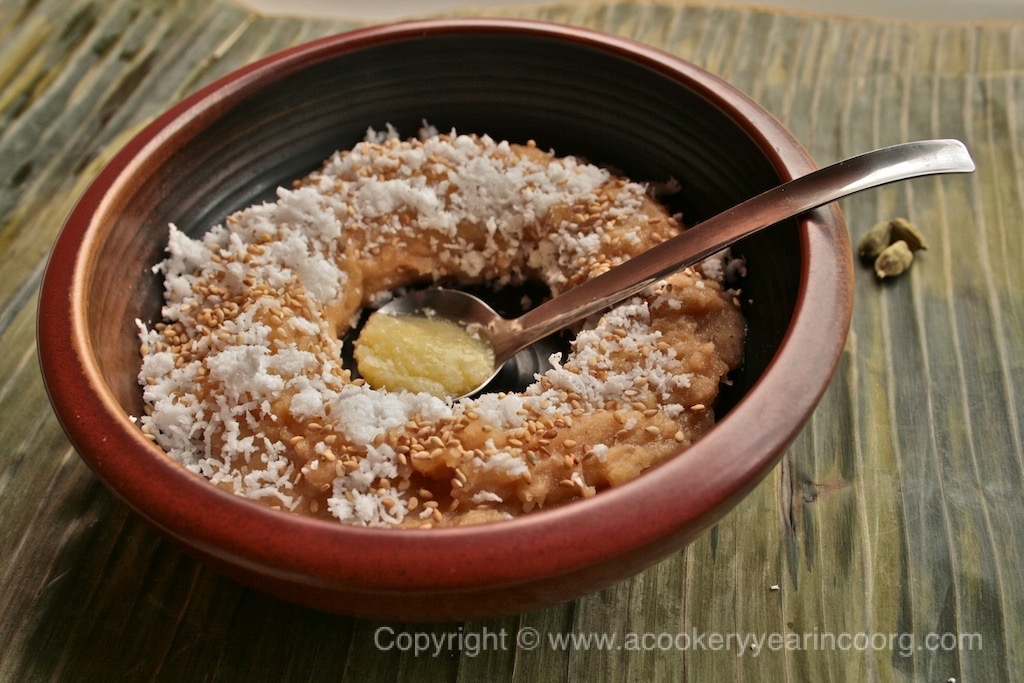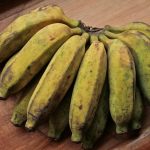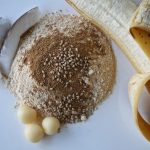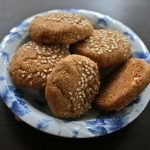The biggest festival in the Kodava calendar, the harvest, known as Puthari, is around the corner. This year it falls on the 10th of December. While I will not be in Coorg to join in festivities there, I will celebrate it in the best way possible with some of my food favourites of the season. One sweet preparation that is typically associated with this time of year is Thambuttu.
Thambuttu is made with the mashed pulp of a local variety of banana known as mara balé. These bananas have a dense, creamy flesh with a subtle hint of tanginess that complements their sweetness.
To make thambuttu, you have to first make thambuttu podi – a flour made from roasted rice, spiced with fenugreek seed and cardamom. The mention of fenugreek here might sound a little odd to some, since it’s a flavour that one tends to associate with savoury, more than sweet. Well, hold your horses till you’ve tried it!
As a child, I fantasized about pouring hot maple syrup on freshly packed snow, to make maple candy à la the Ingalls family in the wonderful “Little House” books. When I first tasted maple syrup, it was like nothing I’d expected, and yet, oddly familiar. The penny didn’t drop until I later read that fenugreek is used to make imitation maple flavouring. The combination of jaggery and fenugreek used in making thambuttu (and a number of other sweets) is very reminiscent of the flavour of some of the lighter grades of maple syrup.
Anyway, on to the thambuttu podi.
Thambuttu Podi
- 1 cup parboiled rice, washed and dried
- 1/4 tsp fenugreek seed
- Seeds from 2 pods of cardamom
On a griddle or heavy pan, gently roast the rice to an even, nutty brown. This may take 15 – 20 minutes or longer, but don’t rush it or you’ll end up with unevenly roasted rice.You can also do this quite easily in the oven, spreading the rice in a roasting pan and shaking the pan occasionally to move the rice around.
Sprinkle on a few drops of water every few minutes so that the rice doesn’t begin to scorch. In the last few minutes of roasting, add the fenugreek, taking care that the seeds don’t turn more than a couple of shades darker. Remove the contents of the pan to another container, stir in the cardamom seeds and allow to cool before grinding to a fine powder. Store in an airtight container.
Now to the thambuttu.
Thambuttu
- 6 Mara balé or 4 of the Cavendish kind
- 5 tbsp of thambuttu podi
- 2 tsp sugar or jaggery to taste
- 1/4 tsp freshly ground cardamom seeds
- A pinch of salt
- 2 tbsp dry roasted brown (unhulled) sesame
- 4 tbsp freshly grated coconut
- Melted ghee
Mash the bananas, thambuttu podi, jaggery and cardamom together. The resulting mix should be smooth but firm enough to hold its shape. Add more podi or banana as necessary. Scoop individual portions onto small plates and make a depression in the centre of each portion. Sprinkle with toasted sesame and grated coconut, fill the depression with melted ghee before dishing up the thambuttu. With its toasty, nutty, fruity, spicy-sweet flavour, thambuttu is the flavour of Puthari for me 🙂
Makes 4 – 6 servings.
This is a substantial dessert, most appropriate for those days of hard work, harvesting paddy in the fields. I’m guessing most readers here aren’t actually doing much of that sort of thing anymore. Don’t let that stop you from enjoying this delicious puthari treat.
For those of you who are still holding out, afraid of those calories, or cowering at the thought of uncooked, mashed bananas (you know who you are!) here’s another way to savour thambuttu:
Thambuttu cookies
- 175 gms thambuttu podi*
- 120 gms ripe banana, mashed
- 60 gms sucanat or 50 gms turbinado sugar
- 60gms freshly grated coconut
- 30 gms ghee, melted
- 1/8 tsp freshly powdered cardamom
- 1/4 tsp baking soda
- 1/4 tsp salt
- 1/4 cup brown sesame (raw)
Preheat your oven to 350°C. Prepare a cookie sheet to hold about 20 small cookies.
Mix all the ingredients except the sesame together to make a soft dough. Make small balls of the dough and dip one half in the sesame. Flatten the balls slightly as you place them on the cookie sheet. Bake for 15 minutes and remove to a wire rack.
Bite into one while it’s still warm and let that thambuttu deliciousness waft over you. Even better, pair this with a hot cup of coffee, sweetened with palm jaggery.
These cookies will soften over a couple of days. They’re still good – they then taste like kajjaya!
*If you’re unfamiliar with the texture of cookies made with rice flour, these may seem a little crumbly and grainy compared to those made with wheat flour.I wouldn’t change this here, because that slight graininess is something that I enjoy in the original thambuttu. I’m still working on refining this recipe and I’d appreciate any feedback from readers who try this recipe out 🙂




